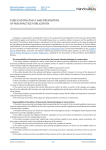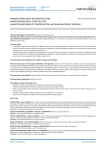Статьи журнала - Nanotechnologies in Construction: A Scientific Internet-Journal
Все статьи: 409
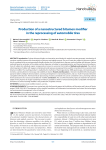
Production of a nanostructured bitumen modifier in the reprocessing of automobile tires
Статья научная
Introduction. Polymer-bitumen binders are innovative nano-binders for asphalt concrete pavement. Introduction of a polymer modifier improves the characteristics of bitumen and asphalt concrete. The use of waste tires rubber for bitumen modification is considered to be an environmentally friendly solution, but it is limited due to the poor cosite of rubber with bitumen. Various methods based on activation of the rubber surface, dispersion of rubber to nanosized particles, and thermochemical transformations of rubber into individual organic compounds are known to overcome this limitation. Methods and materials. The method of joint pyrolysis of rubber with oxygen-containing oil under pressure is proposed to be used for converting it into a nanostructural bitumen modifier. The resulting product is studied by the methods of thermogravimetry, NMR-spectroscopy, chromatomasspectrometry, scanning electron microscopy and solubility in toluene. Results and discussion. It has been established that during joint pyrolysis rubber undergoes devulcanization, cracking and dispersion to nanosized particles, and as a result the product becomes compatible with bitumen. Thermochemical reprocessing of waste automobile tires can be considered to be a promising method for the production of a nanostructured bitumen modifier. Conclusion. The use of thermochemical pressure treatment of waste tire rubber in the presence of oxygen-containing oil makes it possible to obtain a nanostructured product compatible with bitumen for further use of the resulting modifier in the production of asphalt concrete.
Бесплатно
Статья научная
Introduction. In the article we analysed the technology for producing silicon from rice husks. The analysis showed that the production of polycrystalline and amorphous silicon based on rice waste in the form of rice husk solves the simultaneous disposal of rice waste. Rice husk processing produces valuable organic products, and the residual solid waste mainly contains silicon, carbon and other trace metal elements. Therefore, obtaining silicon and silicon-containing materials from rice husk is relevant. Methods and materials. Various methods for obtaining silicon from rice husk are given. Among them, the methods of chlorination and sublimation were chosen, and experimental installations were assembled to conduct the experiment. The object of study was samples obtained from rice husks of Uzgen rice in the Kyrgyz Republic. Results. The composition and structure of rice husks for the production of crystalline silicon were studied. Lime milk was used to purify toxic chlorine-containing gases in the air of the working area and atmospheric air. The condensing system, designed to capture volatile chlorides, has two receivers. In the first receiver at a temperature of 60°C, condensation of iron, aluminum and magnesium chlorides occurs. It has been established that highly volatile silicon (IV) chloride (SiCl4) at a given temperature remains in the gaseous phase and is completely distilled off in the next receiver of the refrigerator. This indicates that the silicon is in the form of SiCl4 (60°C) and condenses only at a lower temperature in the next receiver. The data obtained indicate that when the temperature rises to 200°C, the process of chlorination of metal compounds initiates. The optimal conditions for maximum extraction of metals and silicon tetrachloride from rice husk were identified: temperature 500–550°C and time 120 minutes. Non-volatile chlorides of calcium, sodium, potassium and other elements form a floating mixture at 450°C. During the reaction, metal chlorides harden and settle on the cold walls of the reactor. Therefore, at this temperature there is not enough heat to maintain them in a gaseous state, and they condense to form solid precipitates. Lime milk containing CaO – 130 g/dm2 is a very effective and cheap means for purifying toxic chlorine-containing gases in the air of the working area and atmospheric air. At high temperatures (1050–1100°C), it is possible to activate chemical reactions between the carrier gas (hydrogen) and silicon chloride (SiCl4), which promotes the decomposition of SiCl4 into components, including silicon and hydrogen chloride, and also provides certain conditions for the formation and deposition silicon crystals. Conclusion. A technology for producing polycrystalline silicon by chlorination from rice husks of Uzgen rice of the Kyrgyz Republic has been studied and developed.
Бесплатно
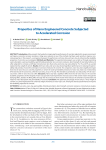
Properties of Nano Engineered Concrete Subjected to Accelerated Corrosion
Статья научная
Introduction. Many research had worked on improving the performance of concrete subjected to severe environment and improve concrete corrosion resistance. Using nano-materials is one of the methods had been used recently to improve concrete properties. In this research, a comparison between the performance of nano-silica and nano-clay in enhancing the durability properties of concrete was investigated. Methods and Materials. The experimental program was carried out through examining water absorption, water permeability, rapid chloride penetration test, corrosion resistance, bond strength of steel rebar before and after subjected to corrosion, and finally microstructure test. Nano-silica and nano-clay were added at 1%, 3%, and 5% as a partial replacement by weight of cement. Results. Both nano-silica and nano-clay showed significant performance in reducing the permeability and porosity of concrete and improve corrosion resistance of concrete. For comparison, nano-clay had a significant impact than that of nano-silica on concrete properties; in which the water permeability resistance of nano-clay mixes was enhanced by 87% than that of the control mix, while for nano-silica, it was 51% only. The chloride ion penetration was reduced by 72% for nanoclay mixes, while in nano-silica was 28%. Discussion. Nano-clay had a significant effect than that of nano-silica on the concrete durability properties; the flat-shaped of nano-clay particles had improved the microstructure of the cement matrix through the damping effect, besides the filling effect through the microstructure of the matrix which reduces the chloride ion penetration and improves water absorption and permeability of concrete. Conclusion. The optimum percentage of nano-silica is 1% by weight of cement as a partial replacement of cement by weight. However, for nano-clay is 5%, which gives the best performance in improve the durability properties of concrete.
Бесплатно
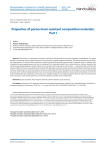
Properties of porous heat-resistant composition materials. Part I
Статья научная
This article is a continuation of a series of articles on the production of porous composite nanomaterials. This paper presents an overview of the properties of porous, heat-resistant inorganic composite materials. The physicochemical and mechanical characteristics of various porous refractory materials produced industrially are presented. A separate class of materials with a regular and quasi-regular porous structure is considered. Such materials include the so-called cellular or «lattice» materials, that are becoming widely applied in modern industry. An example of such materials is ceramic foam – a sintered ceramic material with a foamy cellular structure. A special group of materials with opal pore structure has been also focused. Synthetic opals have received intensive development in recent years because they are model objects for the development and research of new spatial-periodic structures with nonlinear optical properties. Such structures include composites based on classical and inverted opals, in which the pores are filled with various dielectric, semiconductor, or metallic substances. The optical properties of these systems are determined by the size of the close-packed particles, as well as the dielectric constant of the components.
Бесплатно
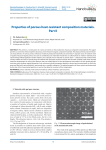
Properties of porous heat-resistant composition materials. Part II
Статья научная
This article is a continuation of a series of articles on the production of porous composite nanomaterials. This paper presents an overview of the properties of porous, heat-resistant inorganic composite materials. The physicochemical and mechanical characteristics of various porous refractory materials produced industrially are presented. A separate class of materials with a regular and quasi-regular porous structure is considered. Such materials include the so-called cellular or «lattice» materials, that are becoming widely applied in modern industry. An example of such materials is ceramic foam – a sintered ceramic material with a foamy cellular structure. A special group of materials with opal pore structure has been also focused. Synthetic opals have received intensive development in recent years because they are model objects for the development and research of new spatial-periodic structures with nonlinear optical properties. Such structures include composites based on classical and inverted opals, in which the pores are filled with various dielectric, semiconductor, or metallic substances. The optical properties of these systems are determined by the size of the close-packed particles, as well as the dielectric constant of the components.
Бесплатно

